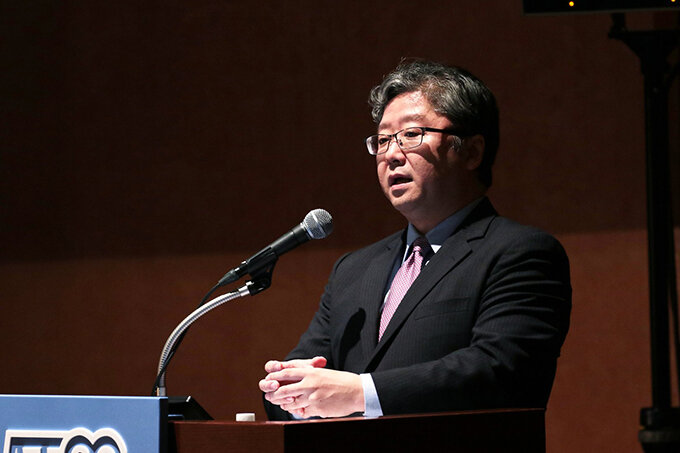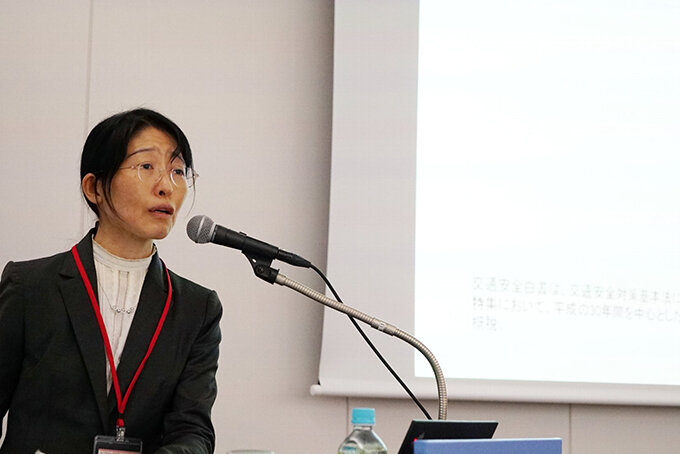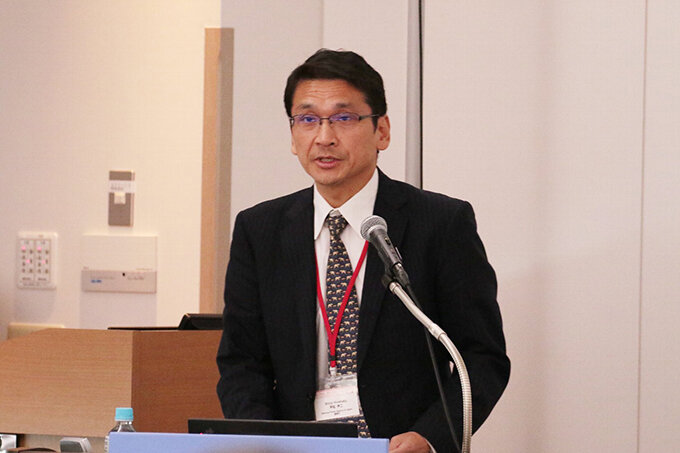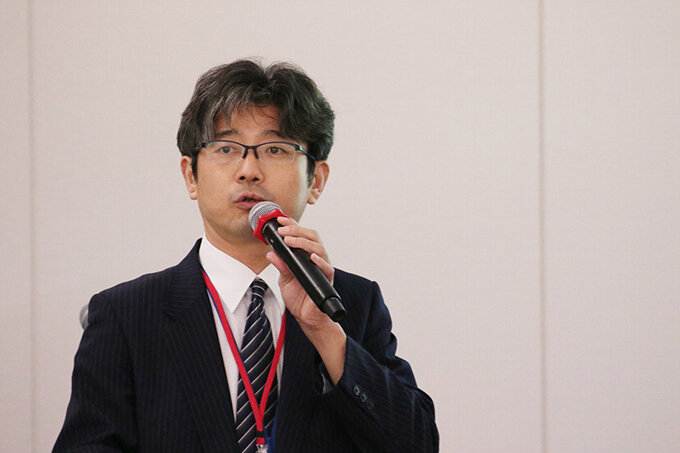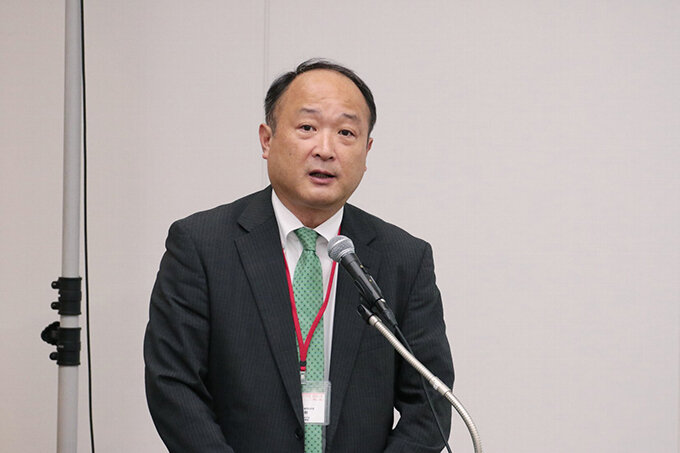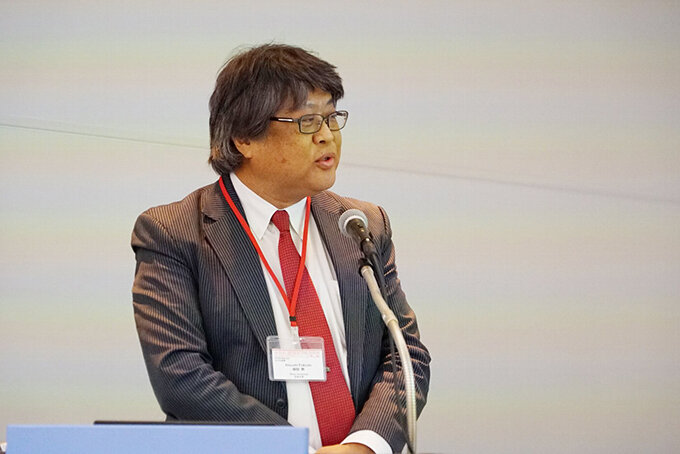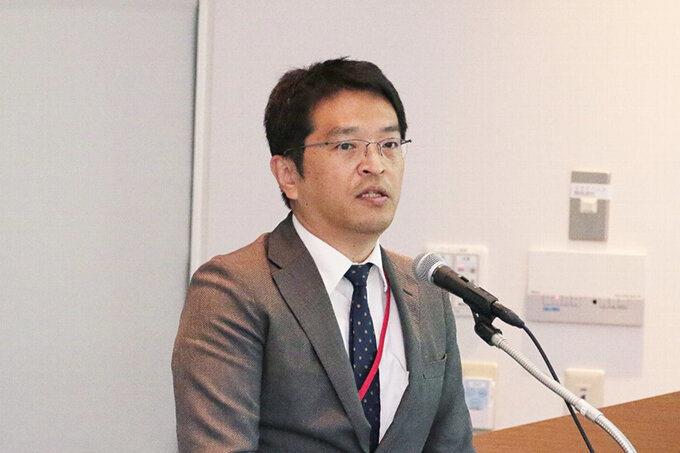THE FIFTH GLOBAL INTERACTIVE FORUM ON TRAFFIC & SAFETY
Symposium
Thank you so much for your participation in the Symposium on 25th October, 2019.
Outline
Title:THE FIFTH GLOBAL INTERACTIVE FORUM ON TRAFFIC & SAFETY
Venue:Ito Hall, Ito International Research Center, the University of Tokyo, 7-3-1
Hongou Shibuya-ku, Tokyo 113-0033, Japan
Date:Friday, October 25, 2019
Host:International Association of Traffic and Safety Sciences (IATSS)
Opening Address
Kazuhiko Takeuchi
IATSS President / Institute for Global Environmental Strategies (IGES) / Project Professor, the University of Tokyo
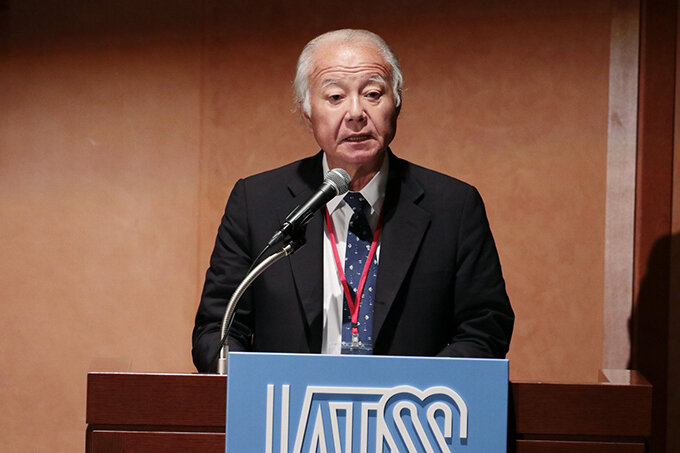
Since its establishment in 1974, the International Association of Traffic and Safety Sciences (IATSS) has conducted various activities for the realization of a society with optimal transportation through surveys, research, and more related to traffic and safety.
During this period, the global transportation situation has undergone dramatic changes. The number of annual traffic accident fatalities has exceeded 1.2 million and is on trend to further increase. Together with responding to this urgent issue, it is also necessary to respond in wide-ranging areas including climate change, global warming, sustainable urban development, and correcting social disparities. Based on this environment, IATSS decided to tackle four long-term policies in 2014, its 40th anniversary.
The first is global safety, meaning global-scale efforts for traffic and safety more than ever before. The second is "traffic culture." As there are different regional and country growth models and social characteristics, the aim is for effective measures responding to respective "traffic cultures" based on the social and cultural background. The third is promoting a trans-disciplinary approach that works together with related people not only in academic fields, but also administration widely relating to traffic, practitioner specialists, users, and others. The fourth is building places for "co-creation" together with people from around the world rather than just Japan to transcend differences in values and culture, hold continuous joint discussions, share issues, and together create a society with ideal transportation.
I believe it is important to hold active discussions regarding measures and effective policies amidst diverse values by widely taking up the backgrounds for the traffic policies of various countries and regions as well as the approaches for prioritizing policy objectives as "traffic culture." I hope that such discussions will develop at today's symposium.
Overview of Objectives
Yuto Kitamura
IATSS Member / Chairman, International Forum Committee / Associate Professor, Graduate School of Education, The University of Tokyo

The global symposium GIFTS has been held four times through now since 2015 as a place for very interdisciplinary discussions and to create opportunities to promote initiatives.
At the symposia over the past four years, there have been many discussions regarding ideal cities, technological innovation, the connection between people's lives and transportation, ideal societies with transportation as public space, and more, with the participation of specialists from all over the world and practitioners at international organizations who have shared their expertise from extensive perspectives.
The goal of IATSS for its 50th anniversary is to more actively convey to Japan as well as the world the research that has been accumulated over many years as well as the expertise and experience for social implementation and social contributions, and for these plentiful resources to be utilized by many people.
In various areas of the world, especially many developing countries and semi-developed countries that are conducting active economic activities, issues in traffic fields are increasingly occurring. It is essential to consider such issues in order to leverage GIFTS and make international contributions befitting of IATSS.
The theme of GIFTS this time was set as "Socio-Economic Development and Traffic Safety: The Meaning of 'Traffic Culture' in International Cooperation in Asia" with the belief that it is firstly necessary to understand Asia, where Japan is located, to understand "traffic culture" in various countries and achieve international contributions.
In his keynote address, Dr. Yasuyuki Sawada, Chief Economist at the Asian Development Bank (ADB), will explain the foundation for discussions considering traffic and traffic safety issues amidst various matters including urban management, industrial promotion, and labor market activation based on urbanization situations in various areas of Asia.
During the discussion in the second half, Dr. Yukihiro Koizumi of the Japan International Cooperation Agency (JICA), Ms. Mirjam Sidik of the AIP Foundation, and Mr. Alejandro Schwedhelm of the World Resources Institute (WRI) will participate.
Today, in order to more stably develop Asia with splendid economic growth while placing emphasis on the diversity of the various countries and regions of Asia, it is necessary to carry out effective measures responding to that in the correct order of precedence. I believe that today we will have a valuable discussion for that.
Keynote Address : Fostering Growth and Inclusion in Asia's Cities
Yasuyuki Sawada
Chief Economist, the Asian Development Bank (ADB)
I would like to report on five topics regarding matters concerning inclusion, including general urbanization and traffic safety in Asia from a wide perspective.
- Urbanization: Some key patterns
Developing Asia is urbanizing rapidly. The urban population was 400 million in 1970, and is now up to 1.8 billion. This shows that up to half of the entire population has come to live in cities. In addition, the speed of urbanization in Asia is extremely fast compared to Latin America, North America, and Europe.
There is a strong correlation between urbanization and economic growth. There is probably a bidirectional causality for this. If there is plentiful growth in a country overall, then demand will grow for the service industry and manufacturing industry products. This spurs urbanization. A flow from agriculture to industry is the same. On the other hand, if people gather in cities, accumulated profit and overall productivity increase. As urbanization progresses, incomes throughout the country are driven up.
Cities expand in a way that transcends administrative boundaries. Therefore, there are some slight inaccuracies in data gathered according to each administrative district. Accordingly, the ADB refers to data of "natural cities" combining nighttime light gathered from satellites and above-ground population data.
It can be said that one of the characteristics of Asia is that relatively small cities greatly expand and are connected to form city clusters. There are 28 enormous city clusters in Asia with populations of over 10 million people. - Urban agglomeration economies in Asian cities
Agglomeration economies yield major productivity benefits through the regional, geographic, and spatial concentration of economic activities. This theory can be explained with the three terms "learning," "matching," and "sharing." Firstly, in agglomeration regions, knowledge and ideas spread transcending people and companies. Next, input and output markets, including laborers, mediators, customers, and others, are matched. It then becomes easy to share infrastructure and leverage extensive specialized knowledge.
There are benefits from agglomeration economies in Asian cities. Particularly in large cities, the wages of laborers with similar backgrounds grow systematically higher. In addition, the more companies are located in large cities, the more they tackle innovation (of products, processes, R&D). The benefits of this agglomeration also play a major role for the many universities located in large cities. Furthermore, the more large cities there are, the more a trend can be seen of lower gender disparities in the labor market in Asia overall. - Managing the city as a labor market
Benefits are not automatically produced through agglomeration. Transpiration systems, land use, land use planning, housing availability, and building an extensive business environment are also majorly involved. Firstly, a functional labor market is essential for cities to thrive. As conditions for this, it is necessary to have methods enabling quick mobility within the city at a low price as well as the ability to acquire real estate at a relatively low price. This is striking in Chongqing, China and Lagos, Nigeria. Many global companies have gathered in Chongqing, which has high mobility, and the unemployment rate is under 4%. In contrast, local companies are concentrated in Lagos, and there is a high unemployment rate at just nearly 30%. Congestion that poses major limitations on laborers is a serious problem for large cities. Google Maps trip information was used to measure congestion in 278 Asian cities. Manila, Dhaka, and Bangalore have severe congestion, results not far from our intuition. The background for this congestion is the dramatic increase in the number of cars in Asia. China has seen a rapid increase in the ratio accounted for by cars from 2005 to 2015. The ratio for developing countries in Asia is growing at twice the speed compared to other developing countries. Congestion issues are also connected to public transportation methods and ease of access to housing. Because city expansion does not follow effective land use planning and city use planning, there are very few roads for areas and housing becomes far away from arterial roads. This increases the proportion of laborers' income spent on commuting expenses in developing countries in Asia, and causes sudden price increases for housing. To control housing prices, it is necessary to increase housing supply and decrease demand. For example, by improving public transportation from city centers to suburbs, housing demand is decentralized to avoid concentration in city centers. In addition, it is also important to have measures such as making it easier to get housing loans, reviewing security systems, and expanding rental housing for the poor. - Managing the urban system
Rather than just growing individual cities, it is important to increase inter-city connectivity by supporting a good balance of overall, diverse urban vibrancy by linking cities together and linking small, medium, and large cities and remote areas. There are business limitations in small cities. Compared to large cities, there are more issues concerning urban access, business approval speed, and infrastructure in small and medium cities. In order to realize vibrant cities, it is important to seamlessly connected several public transportation systems. It is also important to be able to receive affordable housing services. To realize this, it is necessary to appropriately carry out land use planning and regulations. It is also essential to densely connect individual cities and build an urban system in which they all develop. - Road safety in developing Asia and the ADB's recent efforts
Road safety in Asia is majorly deteriorating. Many traffic accident victims are vulnerable riders of two- and three-wheeled vehicles and pedestrians. It has also not been possible to decrease the number of general traffic accident victims in cities in low-income countries. Furthermore, the reliability of the data itself is low and data on the number of traffic accident victims using the same conditions in various countries is not being collected, so there is also the issue of not having a grasp of the actual reality in results. In addition, the increase in the number of traffic accident victims also causes major losses to GDP because of the negative effects on the working-age population. As a solution, it is necessary to collect cross-country data, analyze it, and connect it to policies. The ADB cooperates with other international organizations such as the World Bank, the FIA, and the International Transportation Forum, and has supported for it by the establishment of the Road Safety Observatory (RSO) in March, 2019 as a platform for discussions on traffic safety in the Asia-Pacific region. Similar observatories are established in Latin America and Africa. In addition, a traffic safety incentive program at the state level is carried out with one quarter of the budget funded by an ADB loan and the remaining three quarters funded by the Government of India. After establishing a system to decrease the death rate and setting specific goals for building an observation system, the budget will be distributed in accordance with the level of achievement.
- Developing Asia is urbanizing rapidly, forming city clusters.
- Asian cities benefit from "agglomeration economies," but the benefits do not flow automatically.
- In order to achieve socially inclusive growth, it is necessary for Asian cities to overcome existing issues concerning transportation infrastructure, housing, and urban planning.
- Achieving traffic safety is essential for socially inclusive growth. The ADB contributes to traffic safety in the Asia-Pacific region through innovative programs and other initiatives.
Key messages
Panel Discussion
| Moderator | Akihiro Nakamura | |
| Panelist | Yasuyuki Sawada Yukihiro Koizumi |
Presentation |
| Mirjam Sidik | Presentation | |
| Alejandro Schwedhelm | Presentation |
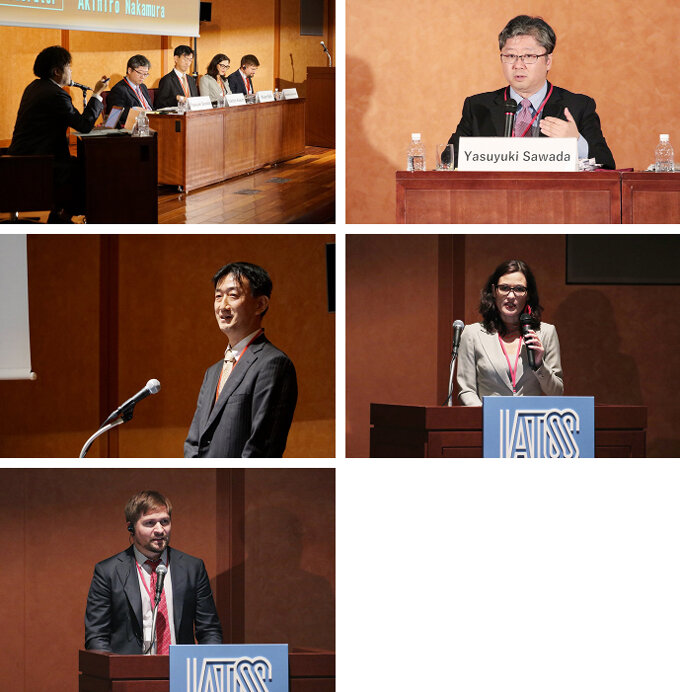
Mr. Akihiro Nakamura, Moderator; IATSS Member; Professor, School of International Management, Yokohama City University, expressed his hopes for a beneficial discussion for all those attending, and introduced the panel members. He introduced the theme of "Socio-Economic Development and Traffic Safety: The Meaning of 'Traffic Culture' in International Cooperation in Asia," a continuation of previous themes at the Global Interactive Forum on Traffic and Safety (GIFTS).
Transport culture itself is a broad term, which has its foundations in the overall relationship between transport systems and traffic safety and how they allow and enable the overall economic development and growth of well-being of a city. He then invited the panel to further expand and clarify on the topic of traffic culture in their presentations.
Mr. Yukihiro Koizumi, Deputy Director General and Group Director for Transportation and ICT Group, Infrastructure and Peacebuilding Department, Japan International Cooperation Agency (JICA) introduced JICA's efforts on traffic safety.
JICA is a governmental organization that provides Official Development Assistance (ODA) to developing countries for purposes including economic development, agricultural development, medical care, urban issues, environmental issues, and disaster prevention. One notable example is the opening of the Mass Rapid Transit System (MRT) transportation infrastructure in Jakarta, Indonesia in March 2019.
JICA's traffic safety programs are primarily facility improvements through financial cooperation and grants, and also implemented through technical cooperation including for human resources development, improving laws and regulations, and formulating urban and transportation master plans, including traffic safety measures.
JICA also develops numerous cooperation programs around the world, including in Asia and Africa. One of them is for traffic safety for administrative officials in various countries as well as a traffic control course held for police officers. There are also educational programs that invite university students from countries including Myanmar, Viet Nam, and Bangladesh to Japan.
The JICA Master Plan is formulated by combining traffic safety and traffic control while taking into consideration of economic growth, population estimation, and urban planning. In the cities of Viet Nam and Indonesia that are developing in a remarkably rapid manner, there are extremely large numbers of motorbikes and bicycles, and traffic accidents often occur involving them. In order to build up traffic safety to prevent such traffic accidents, it is important to enhance public transportation systems and change mobility methods from private to public.
Based on these aims, JICA provides various forms of support. In addition to aiming to open MRT systems in 10 cities in countries including Bangladesh, Viet Nam, and the Philippines by 2025, a flyover at one of the most congested intersection has been constructed in Dar Es Salaam, Tanzania, contributing to alleviating traffic congestion and improvement of traffic safety. JICA is also cooperating to construct traffic lights, pedestrian bridges, motorbike bridges, and guard rails in northern Viet Nam.
JICA's capacity-strengthening initiatives include training for police officers in Hanoi, Viet Nam, wide-ranging education for traffic safety committees, and education for the general public regarding traffic behavior under the urban master plan in Phnom Penh, Cambodia. For the initiative in Phnom Penh, a campaign was conducted with the cooperation of school children, and the method involving the children was extremely effective for improving awareness among adults.
Mr. Koizumi gave a general example of a country, which is telling of motorization in many Asian countries. Between 2002 and 2010 automobile sales accelerated in this country, beyond the GDP growth until an important 1000-GDP-per-capita-marked cutoff line. Likewise the traffic deaths also increased, causing concern. Rapid motorization is unavoidable, therefore an effective mix of traffic measures and policy must be addressed. Technologies such as AI may offer benefits and opportunities for utilization in improving traffic safety.
Ms. Mirjam Sidik, Chief Executive Officer, AIP Foundation, introduced AIP Foundation which is a non-profit organization encouraging injury and fatality prevention in low- and middle-income countries in Asia. The organization has done this work for 20 years to date. Some examples of the foundation's activities are targeting distracted driving, mobile phone use, and speed reduction in school zones through infrastructural modifications. It more broadly focuses on educational measures, behavior changes in social media and mass media, and government cooperation in policymaking and legislation. The organization is mainly focused on the youth as they are the next generation, and using evidence-based research to develop and implement interventions, and cooperating with third-party organizations for traffic safety monitoring and evaluation.
It has been claimed that in Asia Pacific, one person is killed every 40 seconds in traffic accidents. These deaths are disproportionately distributed with 59 percent in Asia in vulnerable populations such as children, the elderly and the poor. The World Health Organization stated in a recent report that the South East Asia region is severely lacking in legal frameworks.
AIP Foundation's measures in Vietnam predominantly focus on the use of motorcycle helmets. As the country saw massive development after the war, and following the current economic changes, motorcycles were seen a symbol of growth. The number of fatalities increased 164 percent in less than 10 years and the number of injuries nearly doubled due to these changes in motorization. Before 2007, helmet use in the country was unenforced and law applied to restricted areas despite the vast numbers of motorcycles.
Vietnam's previous helmet-use campaigns were patriotic posters, and were not based on evidence and thus poorly targeted. The AIP Foundation's efforts in helmet adoption contributed to the passage of a universal helmet law in 2007 which led to a 90-percent increase in helmet use. Using the ADB's Gross Output method, it is estimated that this law prevented 502,774 head injuries, saved 15,302 lives, saving 3.5 billion US dollars, over 10 years.
However, children were in a legal loop hole as they could not be fined, and a newspaper made a notable report from a doctor that claimed that helmets interfere with children's spinal development. As result, child helmet rates remained much lower than adult rates. After evidence-based research into the issue, a more comprehensive law was passed. The lesson to learn from this is that comprehensive policy needs to be adopted from the very beginning.
Presently, sub-standard helmets are commonplace in Vietnam. Measures should therefore be taken to improve the quality at production sites as well as education of the populace, along with roadside enforcement. Comprehensive research comparing the severity of head injuries sustained to the quality of helmets has never been done, which could benefit more widespread adoption of quality helmet use in Vietnam.
Overall, collaboration and coordination with all sectors in an integrated agenda for traffic safety is vital, and this is becoming a reality through the Sustainable Development Goals. However, more investment is needed in roadside campaigns, and more leadership and ownership needs to be taken by politicians. Vision Zero--the idea that all injuries and deaths from accidents are preventable--a shared responsibility of all shareholders, and to not simply blame road users, are vital to adhere to going forward.
Mr. Alejandro Schwedhelm, Urban Mobility Associate, World Resources Institute (WRI) Ross Center for Sustainable Cities, presented on road safety as it relates to traffic safety in Asia, and the fundamental principles in WRI's approach.
WRI is a global research and non-profit organization which does research, technical assistance and capacity building for scaling impact. The Safe System approach is based on principles that are the foundation of Vision Zero programs. The approach has core elements, methods of implementation and actionable elements. Human error is a vital point which necessitates a transdisciplinary approach with all stakeholders, not just road users. Stakeholders working on land use planning, design and engineering, education and capacity building are all essential in providing better traffic safety.
The Avoid-Shift-Improve model focuses on optimizing land use and addressing congestion and lack of accessibility. The Shift element involves having a diverse transportation system that allows users to shift away from automobiles towards safer and more efficient modes of transport, while the Improve element focuses on the electrification of transport to address pollution.
The WRI's data analysis in Bogota, with historical crash data over three years, highlights effective approaches for detecting crash hot spots. Overlapping speed data (when available) will make this analysis more comprehensive. These efforts identified a 10-layer approach for identifying ideal locations for speed reduction and improved road design. Now, WRI is coopering with Thai Roads Foundation in Bangkok gathering data. While it is in a preliminary stage it offers great opportunity for improving road safety in Bangkok.
WRI's efforts in design intervention in intersections, a notable example being Mumbai, can lead to better outcomes for traffic safety. This approach tests and evaluates temporary interventions before they become permanent, leading to safer, more efficient intersections. Effectiveness in crash reductions, led to scaling of this approach in other intersections across Mumbai.
The traffic culture across regions is a crucial aspect to consider, as different areas have different issues. Vulnerable users are uniformly affected by unsafe traffic, however the distribution differs in mode share, with some countries with more motorcycles, and others with more cyclists and automobiles.
Effective road safety interventions include the reduction of speeds and the redesigning of intersections identified as hot spots. Counterintuitively, lower speed limits in rush hour traffic do not affect traffic flow in already congested roads, but are effective in lowering severe crashes at night when a lot of accidents occur. The WRI's approach of tactical urbanism engages both communities and stakeholders. It allows for testing operations, which in turn allows for wider approval for permanent adoption in the said cities, using iterative incremental improvements to bring about change. The positive aspects of this approach are that it draws attention to shortcomings, creates large public engagement, and puts the onus back on the individuals and other stakeholders. These efforts are being conducted in Latin American and African cities, and in Asian cities like Bangkok, Ho Chi Minh City, Mumbai.
Discussion
The Moderator instigated the discussion by calling for questions or comments from the panel.
Dr. Yasuyuki Sawada, Chief Economist, Asian Development Bank (ADB) thanked the panelists for their presentations and said that there were many areas of agreement. He stated that establishing urban master plans is essential to address rapid urbanization and increases in traffic accidents, and asked if it is considered necessary to decrease dependence on private cars by building more comprehensive public transportation systems in the long-term.
Dr. Sawada then suggested that "nudging" road users is the commonality between the WRI's encouragement of traffic safety and guidance toward less dangerous behaviors through GIS and hotspot identification, the AIP Foundation's message in its campaign encouraging wearing helmets in Viet Nam, and JICA's approach in Phnom Penh in which school children were effective educators for their parents.
Mr. Koizumi stated that rapid urbanization and motorization is inevitable in any country However it is possible to suppress use of private transport and promote use of public transportation if appropriate transport masterplan is formulated and public transportation is developed accordingly. Since it takes long time to develop railway transportation system, it is significant to make decision at appropriate timing to develop railway system. Indonesia seems to have had missed the appropriate timing for decision making.
Ms. Sidik stated that thorough research was conducted into reasons against helmet use first. These reasons were then converted into life threats, to shock users to change their helmet use habits. Celebrities, singer and musicians were involved in the measures after the law passed, which helped with the helmet message's popularity. Research in a data-based method was conducted into the effects of helmet use on children's spinal development. The results were found to challenge the previous newspaper-reported claims.
Mr. Schwedhelm stated that there are correlations between vehicle ownership and traffic fatalities. In the Asian region vehicle adoption rates are trending upwards currently. Therefore, there are exciting opportunities and an urgent need in making other modes of transport more attractive, such as the measures implemented in Bangkok. Geocoded crash data revealing clusters of crashes and hot spots is needed with multiple variables, such as the use of helmets, type of road users, and gender, age, time of day, among others. This more complete high-quality data will allow master plans to take a transdisciplinary approach, from education, media advertisement, enforcement, and city planning to make cities safer.
The Moderator stated that transport culture is evident from the differences that can be seen from the presentations, however the commonalties are also a great source of opportunity. He asked for further elaboration on zoning differences and differences in political structures. The Moderator also asked for more information on the differences and commonalities of the projects such as the shocking images used in Vietnam, and the nudges from behavioral economics, traffic interventions in Latin America, and the effective education of traffic police, which may be beneficial for other countries regions in Asia to learn from.
Dr. Sawada answered that the differences between Chongqing and Lagos were due to the master plans and land use restrictions, as well as the different decision-making authorities and incentives in both cities. He explained that regional governments in China have the authority to make land-use decisions, and there was an excellent policy environment including an administrative performance indicator being urban growth through exceptional plans.
Mr. Koizumi stated that 50 cities have developed master plans, which follow surveys from traffic use of citizens. More developed countries have more average trips by road users. However, in countries like Cambodia, the opportunities are more limited, but users tend to return home at lunch, creating a noon peak. This noon peak time is an example of one difference which needs to be accounted for. Countries which heavily depend on motorcycles compared to those which do not, show drastic differences, especially as it pertains to automobile adoption or mass transit adoption.
Ms. Sidik answered the Moderator's comments that peoples' knowledge and attitude to campaigns were not responding well to shock tactics, therefore the agency focused on caring images of family protection. Approaches can be different in both time and culture. The issues must also be looked at holistically, using e-curriculum with learner-centered education. Media, TV and radio were implemental in driving change because users could be involved and ask questions. The number of lives saved by possible helmet laws, led to its adoption by government. Furthermore, Australian police were involved in national and provincial enforcement.
Mr. Schwedhelm added that the cultural differences in a country are important to identify as well as commonalities. Latin America and South East Asia both see growth in modalities such as motorcycles. We have observed that tactical urbanism interventions, especially temporary interventions tend to be more respected over months in several Asian cities than in several Latin American cities, where on occasion they will disappear quickly. Latin American cities are not growing as quickly as in Asia and Africa, therefore building safe and accessible transportation systems as early as possible will highly influence how much cities in these regions can thrive.
The Moderator responded to the talk about a master plan, and the relevancy of shock tactics, the commonalities between various agencies approaches such as JICA and AIP Foundation. He questioned if these methodologies evolve into different master plans depending on different countries.
Mr. Koizumi stated that JICA' master-plan approach could be different from other organizations' approaches. There is a need to involve the local government in projects, such as construction and road implementation measures. These are decided on by local budgets, and thus cooperation is necessary. It is essential to jointly to develop a system that is both practical and functional.
Q&A
The first discussant posed the question to the panel on the obstacles which exist for the adoption of public transportation networks, especially rail, other than the need for international cooperation projects. He noted that the development of public modes of transportation is often very slow compared to motorization.
The second discussant asked the panel about the key effective measures for cities where public transportation is underdeveloped and people rely on motorbikes and or private forms of transport.
The third discussant asked for the panels comments on two issues: ageing drivers in Japan especially in rural areas which face difficulties in maintaining transport and which thus far only have technological solutions, and that in Japan, deaths due to bicycles are increasing despite Japan's level of development.
A fourth discussant asked for further details on the effectiveness of the Mumbai permanent intersections, especially the pedestrian crossings, given that they are relatively new.
Mr. Schwedhelm clarified that three key components that enable pedestrian crossings to reduce fatalities, the extension of sidewalks at intersection corners, reduction of the number of lanes, and subsequently the shortening of crossings. Through testing new video analysis technologies that compare before and after traffic conflict levels among different modes, crash reductions of 70 percent have been estimated.
The Moderator highlighted the countermeasures for elderly as a venerable population, and the lacking development in public transportation.
Dr. Sawada provided an explanation using the Philippines as an example. He stated that before World War II, the Philippines had a nice master plan modeled on Washington DC. However, due to changing government priorities after the war, urban development in line with the plan was not realized. Amidst these circumstances, the Government of the Philippines is advancing two synergistic methods. The first method is mapping traffic bottleneck hotspots and providing targeted investment in transport infrastructure, such as the construction of the Skyway in order to improve access to Manila Airport, which was inconvenient before. The second method is promoting a shift to a transit-oriented system through proactive infrastructure investment, such as the plan to construct a railroad from Clark Airport to Calamba that is supported by the ADB and JICA's support for metro systems.
The Moderator summarized the discussion by identifying socio-economic development being on the other side of the coin as traffic safety. Transport culture, and the term culture itself, brings differences to our attention. And thus, the tools of discussion, survey, and collaboration allow us to adapt and respond to issues as they present themselves. Thus, at IATSS, through the survey we have opportunities to share our knowledge on transport culture.
Closing Address
Satoshi Kamada
IATSS Executive Director

GIFTS was held for the fifth time, and discussions were held with practical direction from diverse viewpoints based on respective differences under various themes. The foundation has been the key phrase of "traffic culture." The traffic field is simultaneously global and extremely local. It is therefore important to understand "traffic culture." I believe that today's forum was an opportunity to understand traffic culture and consider what Asia, Japan, and the IATSS can do for traffic safety.
Seminar & Workshop
Thank you so much for your participation in the Seminar & Workshop on 28th October, 2019.
Outline
Title:THE FIFTH GLOBAL INTERACTIVE FORUM ON TRAFFIC & SAFETY
Venue:Station Conference Tokyo, 6F, Sapia Tower, 1-7-12 Marunouchi Chiyoda-ku,
Tokyo 100-0005, Japan
Date:Monday, October 28, 2019
Host:International Association of Traffic and Safety Sciences (IATSS)
Overview of the Objectives
Yuto Kitamura
IATSS Member / Chairman, International Forum Committee / Associate Professor, Graduate School of Education, The University of Tokyo
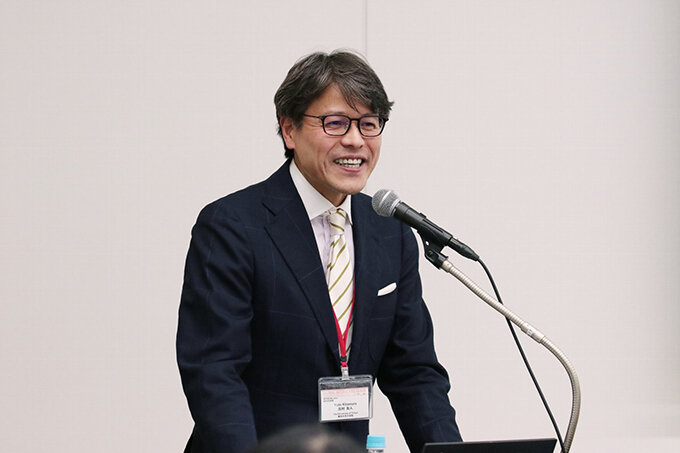
This is the 5th time that GIFTS is being held. The Symposium was held last Friday. Discussions have been held on the key phrase of "traffic culture" since the first time. To build a society with safe traffic that provides peace of mind, discussions were held on how we should provide insight for shared traffic issues as well as unique traffic issues based on the different cultural characteristics of countries and regions as well as based on a global outlook.
Discussions at today's seminar and workshop will be generally based on these themes, but there will be two changes this time. The first is that there will be another review of the conditions and issues within Japan. There will be a focus on the background, main points, conditions, and issues of Japan's traffic initiatives. The second is that the previously privately-held workshop will now be changed to be open to the public. I hope that there will be more active discussions.
Seminar: Traffic Safety Initiatives and Traffic Safety Awareness in Japan
Traffic Safety Initiatives in Japan
Traffic Safety Policies in Japan: Trajectory and Challenges toward the Future
Kyoko Kondo
Director for Traffic Safety Policy, Office of the Director General for Policies on Cohesive Society, Cabinet Office, Government of JAPAN
I will first summarize the changes in traffic accidents over the 30 years of the Heisei period (1989-2019) and then the governance aspect of traffic safety policies through inter-ministerial collaboration. I will then also refer to future challenges.
- Changes in traffic accidents throughout the past three decades of the Heisei period
The feature section of the White Paper on Traffic Safety 2020 provides a data-based overview of the trends and backgrounds of traffic accidents during the Heisei period. Today, I would first like to introduce several points from the White Paper. The number of traffic accident fatalities in 2018 came to 3,532 , about one fifth of the peak in 1970, and less than one third of another peak within the thirty years of the Heisei period; the Heisei period, in particular, the second half, is characterized by a significant reduction of traffic accidents.
Before talking about the Heisei period, let me first review the "First Traffic War". For two decades after 1951, with the growing number of privately-owned vehicles, the number of traffic accidents significantly increased, in particular, those harming automobile drivers and passengers, and head-on collisions. In addition, fatalities of pedestrians crossing the roads increased, due to an insufficient number of traffic lights and other facilities. In 1970, the number of fatalities rose to 16,765 and traffic accidents had become a social problem, the Traffic Safety Policies Basic Act was thus enacted in the same year and the 1st Fundamental Traffic Safety Program was formulated in the following year.
The number of traffic accident fatalities once fell to 8,466 in 1979 as a result of national traffic safety policies, but started increasing again gradually, from the late 1980s and reached 11,452 in 1992. This was known as the "Second Traffic War." The White Paper 2020 focuses on the period after this time. The number of automobile driver and fellow traveler fatalities surged particularly in the second half of the 1980s, when the second baby boomer generation reached the age in which they could acquire driver's licenses, leading to an increasing number of young, unskilled drivers. The number of fatalities once again began to decrease from 1992, falling to below 10,000 in 1996.
Regarding the number of traffic accidents by situation during the Heisei period, the number of automobile driver and fellow traveler fatalities, which was the largest 30 years ago, peaked in 1993 and then fell 40% over 10 years, and the number of walker fatalities has exceeded them in the 2010s, thanks mainly to the improvement in the rate of wearing seatbelts, widening use of airbags, and anti-lock braking systems (ABS) becoming standard equipment. By age group, the percentage of fatalities of elderly people aged over 65 rose from about 20% during the early Heisei period to over 50% in 2010 for the first time.
Let me then examine the statistics from the three aspects of "people", "road", and "vehicle". Firstly, regarding "people", the Heisei period is characterized by an increase in female drivers. Secondly, by age group, over the last 30 years, the share of license holders aged 16 to 19 has become one third, while the share of drivers aged over 70 has grown by ten times. The aged driver problem, raised since the end of the Showa period, has become an important challenge of a different nature, as today the percentage of the elderly population has reached about 28%.
Lifestyles have also changed during the past 30 years. An increasing number of suburban shopping malls and other facilities has led people to make lifestyle changes and now go shopping there by car. Also, an increase in restaurants and shops open during nighttime has encouraged people to go out in the evening and at night more frequently, leading to the number of fatal accidents during the night exceeding that of daytime from the end of the Showa period to the mid-Heisei period.
Secondly, regarding vehicles. the number of privately-owned vehicles, mainly passenger cars, increased dramatically during the 1960s-70s, and passenger cars, compared to trucks and two-wheeled vehicles, thus accounted for the overwhelming majority of vehicles on the roads from the late 1980s and throughout the Heisei period. Regarding the type of primary parties' vehicle, automobiles remains consistently over 70%, although the number of accidents decreased to one third in 30 years.
Thirdly, regarding road infrastructure, road length increased throughout the Heisei period. Large-scale infrastructure improvement progressed, and large-scale projects that had started during the Showa period were completed one after another.
Throughout the 30 years of the Heisei period that saw dramatic changes in all three aspects of "people", "vehicle", and "road", traffic accidents continuously decreased. - Traffic safety policies through inter-ministerial collaboration
From the viewpoint of traffic-safety related governance, a wide range of ministries are working for traffic safety. The Traffic Safety Policies Basic Act was thus enacted so that the relevant ministries work in close cooperation. In addition to the governmental sector, the private sector and citizens are also important. The Spring and Autumn National Traffic Safety Campaigns are held with the cooperation of numerous supporting organizations. This national campaign is known by about 70% of respondents, but the percentage was smaller among the young generation. I would like to invite you to think together about how to inspire the younger generation to get involved.
In order to address traffic safety comprehensively, the Fundamental Traffic Safety Program has been formulated 10 times, and traffic safety policies in the land, sea, and air sectors have been promoted based on the program. The Program is key for diverse ministries to share the same goal, and collaborate closely with each other.
Let me briefly talk about key issues highlighted in the Programs during the Heisei period. The 4th Program (1986-1990), which spanned from the end of the Showa period to the early Heisei period, anticipated an increasing dependence on automobiles, and stressed that it would not be feasible to curb the increase in accidents, unless integrated policies that could deliver sufficient solutions for further acceleration of quantitative and qualitative changes towards the 'car society', could be proactively implemented in an unparalleled way. Also, the program focused on the increase of accidents by elderly people and used the term "elderly drivers." The 5th Program (1991-1995) highlighted the changes in lifestyles active in the evening and nighttime and countermeasures for evening and nighttime accidents. It referred also to the newly introduced license limited to automatic transmission cars, and paramedics. The 6th Program (1996-2000) described traffic safety education targeting people with disabilities, and foreign people. The 8th Program (2006-2010), at the beginning of the second half of the Heisei period, formulated for the first time after Japan's population began to decline, clearly set the "People-First" philosophy, which has been defined as the goal in the succeeding 9th and 10th programs.
The current 10th Program(2016-2020), applies across diverse policies and, first of all defines as "priorities to reduce damages caused by traffic accidents", "securing the safety of elderly people and children", "securing pedestrian and cyclist safety", and "securing safety on local community roads". Secondly, the Program also identifies three "priorities in order to create an environment where traffic accidents are less likely to occur", including "promotion of the use of advanced technologies", "promotion of measures tailored for diverse situations by examining data on traffic conditions", and "promotion of community-based traffic safety policies. - Recent traffic safety policies and challenges
For these recent years, traffic accidents by elderly drivers have been raised as a challenge facing traffic safety. Fiscal year 2019 saw traffic accidents that occurred one after another, including those with child victims and those caused by elderly drivers, and a meeting attended by ministers in charge of traffic safety policies was held in May 2019, and the ministerial meeting adopted the "emergency countermeasures" in June. It is essential to aim for a society in which elderly people and people with difficulties to move can enjoy independent lifestyles. There is a need for further progress in technology.
Another challenge could be the gradual increase in the number of traffic accidents caused by foreign people. Taking the opportunity of the Olympic and Paralympic Games, we need to think about working on traffic safety by carefully considering the increasing diversity of people involved in transportation.
At the Ministerial meeting in June, the Prime Minister issued instructions based on the view that traffic safety policies that can meet the needs of the times are greatly needed, in light of the strong demand for realizing a society that can effectively help progressive aging and warmly supports childrearing. I would like to take the opportunity of today's symposium to think about traffic safety as society changes. Thank you very much for your attention.
Characteristics of Fatal Traffic Accidents, etc. and Police Initiatives
Shinji Hiramatu
Director for Traffic Safety, Traffic Planning Division, Traffic Bureau, National Police Agency of Japan
I will look at changes in the number of fatalities in traffic accidents over 10 years by all age groups and elderly people aged over 65. Although accidents are decreasing for both groups, overall the decrease is slower for elderly people. In comparisons of the ratio of traffic accident fatalities within 30 days of an accident by country and age group, elderly people accounted for the majority at 56.6% in Japan, a considerably higher percentage than major Western countries. For the number of cases of fatal accidents per licensed driver population of 100,000 by age group of the primary party driving a "gentsuki" (two-wheeled vehicle with an engine up to 50 cc) or that with a larger engine, there were 2.4 times more accidents caused by drivers aged over 75 than others.
For changes in the number of traffic fatalities by condition, the most fatalities occurred among people walking consistently over 10 years. For comparisons of the ratio of traffic accident fatalities within 30 days of an accident by country and condition, more than half of fatalities occurred among people walking or riding bicycles, a higher number than various countries. Looking at the five year total for ratio of traffic fatalities by condition and age group, elderly people accounted for 71.5% of people killed while walking, which accounted for 25.9% of all fatalities. Elderly people accounted for 65.8% of people killed while riding bicycles, which accounted for 8.7% of all fatalities. In the same way, looking at the ratio of infants and elementary school children in the number of traffic accidents, over half were walking for both groups.
For the situation of legal violations by traffic accident victims who died while walking or riding a bicycle, in general there was a high ratio of legal violations. Among elderly people who died while walking, over half of those with legal violations were crossing violations. For traffic accidents related to mobile phone use, etc., accompanying the increase in using smartphones while moving, the number of incidents has soared and there have been about 2.1 times more fatal accidents.
Police initiatives based on these conditions have been measures for elderly people, measures for infants and children, and revision of the Road Traffic Act.
- Measures for elderly people
Publicity/awareness raising as well as traffic safety education for elderly walkers and bicycle users. 1) Lectures, advice and guidance on traffic rules and manners. Awareness raising regarding rules at crosswalks without traffic lights. 2) Traffic safety education using simulators. 3) Hands-on experience on such matters as visibility effects at night. Experience for testing the effects of reflective materials as a countermeasure against the large amount of traffic fatalities that occur around dusk. 4) Promotion of dissemination of "safe driving support vehicles." Promotes consideration of a license system limited to safe driving support vehicles, confirmation of driving abilities when elderly people renew their licenses etc. - Measures for infants and children
Measures for ensuring the safety of children centering on preschoolers. 1) Extraction of hazardous locations in cooperation with related agencies. 2) Traffic safety guidance and control in community roads where many children pass through. In addition, efforts are made to spread awareness of traffic safety by conducting traffic safety education for infants and children. - Revision of the Road Traffic Act
There are mainly two pillars of the revision in 2019. 1) Strengthening of penalties on the use of mobile phones, etc. These have become considerably severe. If an accident is caused, it is subject to a fine or penalty and there is the possibility of immediate suspension of one's driver's license as an administrative measure. It will enter into force from December 1. 2) Response to automated driving. The automated driving system takes control under certain requirements only, and besides these requirements and failures, it is necessary for the driver to take over driving. This will enter into force next spring. I also believe that it is necessary to have consideration that includes designing a system that responds to tailgating.
Priority Items in Road Traffic Safety Measures
Tadashi Hamada
Director, Environment and Safely Division, Road Bureau, Ministry of Land, Infrastructure, Transport and Tourism
There are about 1.22 million kilometers of roads in Japan. The breakdown is limited highways, arterial (trunk) roads, and community roads. Limited highways and arterial roads account for about 76% of automobile traffic volume, but it is lower in Japan compared to other countries. Within that percentage, the share of national expressways and national highways under jurisdiction of the MLIT is increasing and automobiles are decreasing on community roads, which is effective for reducing pedestrian accidents from a macro perspective.
In response to a heartbreaking accident in the first half of this year, attention is focusing on improving the traffic safety environment for preschoolers and other children. This time, road administrators around Japan are being called on to work on not only localized measures but also areal measures and arterial road measures, and are being requested to standardize areal measures in particular. The representative areal measure is 30 km/h zones by police, and there are now 3,700 zones throughout Japan. However, the reality is that speeds do not drop much by only adopting regulations.
Therefore, in conjunction with regulations, it is hoped to further increase efficacy of areal measures by promoting installation of physical devices for lowering speeds and issuing alerts. The key for establishing physical devices is forming agreements in areas. This is the extremely difficult part. The example of Niigata City is a good reference model for an areal measure with physical devices, and the agreement was formed with cooperation from the IATSS and local government personnel.
However, it is not a situation in which personnel at local governments around Japan with such an ability to reconcile differences can be assigned just for traffic safety. Therefore, when such personnel conduct discussions regarding regional future conditions, such as creating bustling activity and facility management, or conduct formation of agreements regarding issues with high affinity, such as crime prevention and disaster prevention, it is considered that having them conduct discussions on traffic safety in conjunction would be reasonable for promoting consensus building on area measures.
When developing familiar policies for enhancing safety of community road areas, rather than having the central government indicate uniform improvement policies and options, it is considered more effective to have people who are motivated by the future conditions in their region consider policies suitable for the regional conditions, and have them support consensus building.
Attitudes Towards Traffic Safety in Japan: From ESRA2に
Hideki Nakamura
IATSS Member / Professor, Nagoya University
The issue of traffic safety concerns people, roads, and vehicles. Speaking from the people aspect, I would like to report on the awareness of traffic safety among Japanese people.
Overview of the ESRA2
The ESRA2 (E-Survey Road Users' Attitudes) is an e-survey of road users' attitudes by a joint initiative of road safety institutes, research centers, public service organizations, and private sponsors from all over the world. IATSS participates on behalf of Japan.
The objectives are to collect and analyze comparable data on road safety performance, in particular road safety culture and behavior of road users, and to use it as data providing scientific evidence for policy making at national and international levels.
It is implemented in various countries, and compilation is conducted at the VIAS Institute in Belgium. Currently, there is participation from 32 countries centered in Europe. Only South Korea, Japan, and India participate in Asia. Through an appeal by IATSS, it has been decided that Vietnam, Malaysia, and Thailand will participate from 2019.
In ESRA2, examination is conducted on psychological aspects in the backdrop of traffic behaviors through the results of the self-reported survey. The surveys are conducted online, and it is prescribed that the sample size should be over 1,000 in each country. The age range is people over 18 years old, there are editions in 42 languages, it is composed of 28 question themes, and it takes about 20 minutes to answer. It was held in December 2018 in various countries.
The major topics and themes are as follows. Support for road safety policy measures, self-reported behavior in traffic, acceptability of safe and unsafe traffic behavior, attitudes towards safe and unsafe traffic behavior, subjective safety and risk perception, involvement in road crashes, and enforcement of traffic laws. In addition, the current survey was characterized by the introduction of vehicle automation and bonus questions set by each country.
In Japan, the survey was implemented online from December 14-25 last year. The sampling was made as close as possible to the population composition of Japan. The sample size was 980. Totalization was conducted through use of this sampling.
International comparisons regarding basic statistic amounts from ESRA2 are conducted by the Secretariat. Japan is usually compared against the averages in Asia, but taking into consideration the small number of participating countries in Asia and the fact that Japan is a developed country, this time results were compiled comparing Japan with the averages in the EU.
Japan's characteristics compiled in the ESRA2 are as follows.
- Feeling of safety about transport modes except public transport is relatively low (there is awareness of risk)
- Both past frequency and acceptability of driving after drinking alcohol are significantly low
- Both past frequency and acceptability of use of a mobile phone while driving are low
- Both past frequency and acceptability of now wearing a seatbelt as a driver are low
- Both past frequency and acceptability of driving after taking drugs other than medication are relatively high
- Driving when so sleepy as to have trouble keeping eyes open is relatively frequent
- Both past frequency and acceptability of not wearing a seatbelt in the back seat are high
- Past frequency of driving faster than the speed limit is similar to the EU, but acceptability of this is low
- Number of times having been subjected to an alcohol check is low
- Highly interested in vehicle automation
Comparison between Japan and the EU averages
- Males and young drivers are more likely to drive after taking drugs/alcohol
- Males and middle-aged and late middle-aged drivers are more likely to drive faster than the speed limit
- Motorcyclists, particularly young and late middle-aged motorcyclists, are likely to drive faster than the speed limit
- Many pedestrians, particularly the young generation, check social media or wear headphones while walking
Self-declared behavior
- Personal < Others'
- Female < Male
- The younger, the higher the acceptability
- Acceptability of speeding is high (inside built-up areas < outside built-up areas < motorways)
Acceptability of unsafe traffic behavior
- Males, young people, and the group aged 45-64 are more likely to speed
- Males and young people are more confident in their abilities to take unsafe traffic behaviors
- Males assess contribution of various unsafe traffic behaviors to traffic accidents higher
- Females are more likely to intend to take safe traffic behaviors
- Females and elderly people are more likely to respect legal regulations
Attitudes
- Percentage of those who support measures for preventing driving after drinking alcohol is as high as about 80% and increases with age
- Requiring cyclists under the age of 12 to wear a helmet is highly supported
- Prohibiting use of earbuds while riding a bicycle is also highly supported
Support for policy measures
- Likelihood of being checked for speeding or not wearing a seatbelt is perceived as high, particularly by males and young people
Likelihood of enforcement
As an issue going forward, although simple totals, age, and gender were only looked at this time, I believe there is room to compare these results with other statistical data and analyze it. In addition, cross tabulation across themes is also necessary. Furthermore, the essential purpose of such a survey is for attitudes and normative beliefs to turn into intentions and habits resulting in action, and in some cases for analysis of causes and effects leading to accidents to be conducted. It is therefore important to continue to conduct this analysis.
Question and Answer Session
〇It was mentioned that the surveys will be increased in Asia from FY2019. In Thailand, there will probably be completely different statistical results. It is about awareness of protecting pedestrians, awareness of feeling that drivers take priority, and other matters. Is it necessary to conduct this survey with the awareness to be able to say that common sense in Japan isn't common sense in Thailand, and vice versa?
Dr. Nakamura: Even though they are in Asia, they are completely different. We wanted Vietnam, Malaysia, and Thailand to participate precisely from that viewpoint. ESRA2 works to clarify those differences. I hope that IATSS references this survey to consider traffic problems in Southeast Asia.
〇It was mentioned that it is better to compare Japan with the EU, but I believe that road use conditions in Japan resemble those of Asia more. I learned that it is necessary to compare with other cultures such as the EU to understand Japan's traffic culture.
Dr. Nakamura: At first, it was planned to compare Japan's survey results with the averages in Asia. However, they were compared with the EU averages because few Asian countries participated and Japan is a developed country in terms of economic standards
Dr. Kitamura (Chairman): We have said that the three Es (engineering, enforcement, education) are important for approaching traffic safety. Legislation is established amidst various social changes, people's awareness changes, technology improves, and the three Es are involved. That is Japan's traffic culture. We believe that rather than limiting traffic culture to now, it is necessary to look at it continuously.
Workshop: International Trends in Traffic Culture and Traffic Safety Initiatives
Introduction of IATSS Research Projects in Asia
Atsushi Fukuda
IATSS Member / Professor, Nihon University
The first IATSS research targeting Asia was a study that began in 2002 on the roles and limitations of motorcycles as a means of urban transportation in developing countries.
This research actively positioned motorcycles, which tend to be viewed in Asia as problematic due to their rapid increase in number, as an effective means of urban transportation, and examined the current state of motorcycle usage, etc.
Following this, multiple projects were implemented within IATSS to determine whether or not it would be possible to apply the results and knowledge obtained in Japan to the increasingly intensifying traffic problems in Asia, particularly in terms of traffic safety.
- Strive to deeply understand the culture and situation of Asian countries
- Based on the outcomes of many IATSS research projects conducted in Japan
- Gain a new perspective and implications for Japan
- Many projects have been conducted based on the community approach
The characteristics of the IATSS research projects targeting Asia are compiled in the following four points.
For example, support for implementing information sharing-type traffic safety measure schema in Southeast Asia was conducted in Thailand and Malaysia based on expertise from research implemented in Japan, which was the series of research projects related to citizen participation-type traffic safety measures that was a success in Kamagaya as well as the series of research projects related to "near-miss accident" map creation.
Currently, although the aim was localization and lateral expansion through development of traffic safety measure tools targeting model areas and creation of guidelines, the Ministry of Land, Infrastructure, Transport and Tourism and JICA decided to promote full-blown traffic safety measures in the form of introducing results of this research project, and it is expected that this will make major social contributions going forward.
Next, for advice relating to community-based planning and design in groups of small-scale Indian cities and social implementation initiatives, street design guidelines targeting communities in Agra were created over three years, which has now entered its second phase. The project is characterized by its system in which the Indian Institute of Technology Delhi (IITD) takes action and the IATSS provides proposals. In addition, there is strong consciousness of the SDGs, so in addition to street design, analysis is conducted on air pollution and traffic accidents. Through these initiatives, I believe it was possible to recognize the current situation deeply and share the substantial problems.
Introducing Case Examples of Analyses of Actual Situation of Use of Two-Wheeled Vehicles by High School and University Students in Phnom Penh, Cambodia
Nagahiro Yoshida
IATSS Member / Associate Professor, Osaka City University
This study was conducted in consideration of how to spread the new concept of the safe system approach in developing countries. I would now like to introduce a project searching for clues to reduce the many motorcycle accidents experienced by high school and university students in Phnom Penh, Cambodia.
A questionnaire survey and behavior survey were conducted using a behavior reason model. With a focus on mental aspects of traffic, it was aimed to hold a workshop to improve the reasons for why people take certain actions. Cameras were installed to record actual driving conditions, and comparisons were conducted on how driving styles changed before and after taking the workshop.
The analysis results were that particularly among young people, the trend was that being late due to traffic congestion or other factors leads to rushing, which leads to slight violations, which has the high possibility of ultimately committing a major violation. In addition, according to the workshop that presented content such as risk predictions, it was shown that driving behavior was improved. In other words, driver's education is important in Cambodia, and it is essential to enrich education content and to foster normative consciousness.
In conclusion, it is necessary to once again reconsider license systems, instruction systems, and education content. In addition, road infrastructure is insufficiently maintained. There is also absolutely no understanding of the safe system approach, and slight violations often lead to major traffic accidents. Therefore, based on the Sustainable Safety concept, which originates in the safe system approach, it is necessary to suggest measures to divide infrastructure for motorcycles, cars, and pedestrians.
Unfortunately, there is a major gap between reality and the current analysis, and much research support is necessary for this. However, this is precisely why the IATSS should carry this out.
Some Issues on Urban Transportation and Traffic Safety in Asia
Fumihiko Nakamura
IATSS Member / Vice-President, Yokohama National University
I would like to raise four keywords for considering urban transportation: walkable, reliable, enjoyable, and sustainable.
For "walkable," we should consider ensuring safe spaces, appropriate use, sharing with buses, underground roads, waterfront redevelopment, and responses to tropical weather.
For "reliable," we should consider elevated railways, bus rapid transit systems, small vehicle use, and online motorcycle taxis. From when public transportation first comes into existence, residents should be aware of it, understand its usability, and know how to use it. If that does not happen, people will use more familiar, private methods such as cars. In that sense, subjective trust is necessary, so it is essential to take into consideration compliance with laws and delays due to congestion.
For "enjoyable," we should consider stations with sea views, markets inside stations, markets and bus terminals, morning markets, colonial buildings and streets, and stations with parks and squares.
Cities should be centered on people, environmentally-friendly, and considerate of history. Based on this idea, our goal is safe and sustainable mobility building to ensure freedom and mobility choices. The keywords walkable, reliable, and enjoyable I just raised are important perspectives for that.
Sustainable means achieving balance with a tradeoff between the environment, the economy, and society. It is necessary to skillfully combine walking, bicycling, and public transportation, efficiently utilize existing methods, and consider elderly people and people with disabilities, which is premised on the education and different traffic cultures. The IATSS should play a major role for this.
Discussion
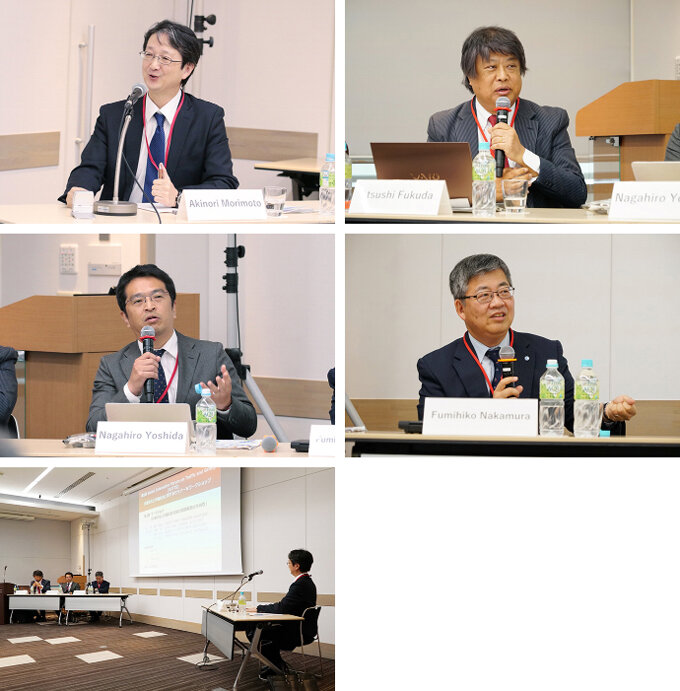
Dr. Fukuda: In many Asian cities, the surge in cars and motorcycles is still continuing. For this, transit-oriented development (TOD) is conducted. Railroads are built, and condominiums are successively built along the lines. However, many of the people who live along the rail tracks use their own cars instead of the railroads. To realize a society that does not use cars as much, it is necessary to consider how to decrease large parking lots or make them harder to use.
Dr. Nakamura: TOD aims for societies that are not dependent on cars by building residences along convenient public transportation routes and placing the foundation for public transportation. However, residents will not use public transportation in conditions such as if using a car is faster or there are difficulties in using the public transportation itself. For this discussion, I believe it is a good plan to control parking lots as a measure.
Moderator Akinori Morimoto (IATSS Member; Professor, Waseda University): I believe it should be appropriately guiding demand through freedom of mobility and expanding mobility choices. On the other hand, if we do not take policies that consider the users' traffic culture, after five or 10 years, it is possible that it will occasionally take an unexpected direction.。
Dr. Yoshida: Freedom of mobility is an important viewpoint. In Japan as well, there is not a perfect road use structure for vulnerable road users such as pedestrians, bicyclists, and motorcyclists. In addition, from an urban perspective, roads are divided hierarchically by numerous function, such as avenues and arterial roads. However, in Asia, including Japan, that is not sufficiently discussed. It is necessary to suggest this way of thinking a little earlier to decision-makers in developing countries when conducting road maintenance going forward.
Moderator Morimoto: In Japan, there is not a sufficient structure for assessing and maintaining roads as a network. I believe spur of the moment responses had to be made according to each area when maintaining roads. I think that is the fundamental reason why traffic accidents do not decrease on community roads.
Dr. Fukuda: There are extremely few research publications from Japan in overseas traffic safety societies. There is also almost no participation by Japanese people in international conferences where global traffic safety-related organizations gather. It is essential to seriously consider Japan's approach to traffic safety research. The result of reducing traffic fatalities by about half in the nine-year period from 1970 and the ITARDA data are extremely famous, and the world has shown high interest in Japan, but it is said that they do not know which institution would be good to access. I strongly hope that IATSS will play a central role for this.
Moderator Morimoto: Are there any other concepts about traffic safety that can be shared besides the three Es?
Dr. Yoshida: Generally speaking, there are two other Es. One is "encouragement." It is a concept of encouraging safer traffic. An environment is provided in which users make choices by appropriately assessing risk. Next is "evaluation." There is a massive amount of data related to cars. On the other hand, there is almost no data on pedestrians, bicyclists, and motorcyclists. Things that do not have data are not subject to analysis, i.e., they do not exist. Therefore, coping measures are not known when the number of traffic accidents rises in developing countries. Firstly, it is important to acquire such related data and share this global concept.。
Dr. Nakamura: There are discussions on what the future vision is (goals), processing tools for that, and consideration frameworks. Particularly in Asia, when responding to unanticipatedly swift changes, it is necessary to share a clear vision.
Moderator Morimoto: Shared concepts are absolutely essential. Methodologies differ in different regions and cultures. I believe consideration must be conducted with each region.
Dr. Fukuda: During work on traffic safety in Thailand, although Thailand has its own technologies, there are missing parts for compiling them for working on traffic safety, so they said they would like the assistance of Japan for that. In order to respond to that request, I believe we must become able to talk with foreign countries to precisely arrange structures such as that of the Kamagaya model.
Question and Answer Session
〇Pedestrians, bicyclists, and motorcyclists account for about 70% of fatalities in Japan overall. It cannot be said that it a developed country in terms of transportation. I would like traffic safety to be considered personally instead of as someone else's problem.
Moderator Morimoto: It is extremely important to think by putting yourself in the victim's shoes. On the other hand, as researchers and administrators, it is also considered necessary to work on this problem from subjective, objective, and comprehensive perspectives. From these three, traffic safety is thought about from the major perspectives of implementation in society, evidence-based correct understanding, and community-building, and it seems it is important to seek solutions together from the perspectives of comfort, enjoyment, and sustainability.
Closing Remarks
Yuto Kitamura
IATSS Member / Chairman, International Forum Committee
Associate Professor, Graduate School of Education, The University of Tokyo
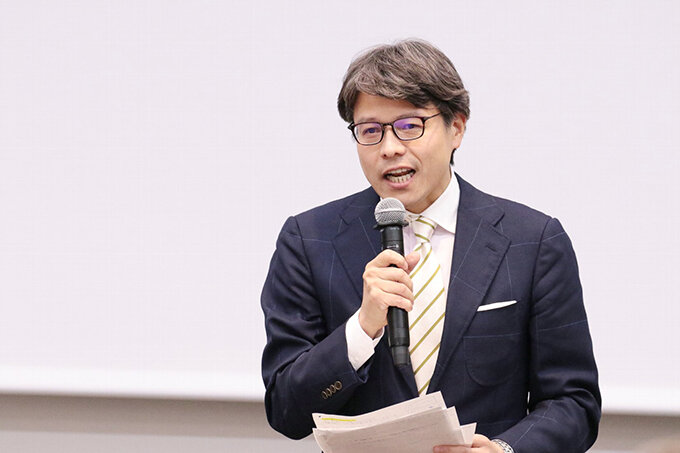
We discussed again the fact that this association's mission is to promote building people-focused, safe transportation societies that provide peace of mind by perceiving it personally while making interdisciplinary connections with society. Going forward, I would like to develop activities using very interdisciplinary approaches for conducting research together with citizens, policy makers, and people from various industries.

